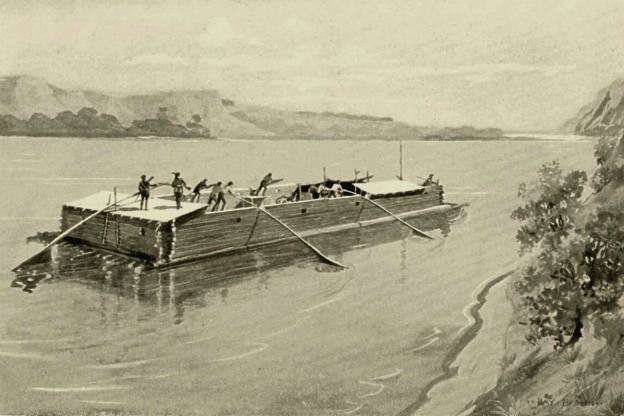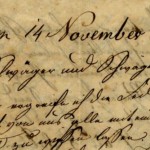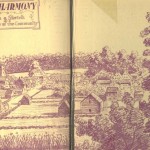For a typical young man living in rural Indiana in the 1830s, there were few grand adventures to be enjoyed. But on December 20, 1834, twenty-two-year-old Asbury C. Jaquess, part of a large extended family that farmed in Posey County, Indiana, was able to set out on such an adventure as part of the crew of the flatboat Davy Crockett headed down the Ohio River to the Mississippi River and on to New Orleans.
Indiana farmers were faced with limited local and regional markets for their grain and livestock. By the 1830s, more than one thousand flatboats arrived at New Orleans every year, laden with the products of enterprising farmers. Some of the men aboard these flatboats were Hoosier farmers, who knew that if they could navigate the long journey safely they could find good prices for the products of their year’s labor, both along the river on the voyage and at the end of the trip in port.
The Davy Crockett was 80 feet long and 17 feet wide – larger than most flatboats but still not of uncommon size. It was loaded with 14,000 pounds of barrel-packed pork and beef; 350 live chickens and almost 500 live turkeys in crates; 1700 bushels of corn and 15 bushels of oats; and 40 kegs of lard. Asbury was one of the five members of the crew and probably the least experienced, for he was appointed to be the clerk for the voyage.
As the boat made its way south during the winter of 1834-1835, Asbury recorded the dangers of navigating the large and heavily laden boat; the welcome of meeting other flatboaters and sharing food and stories with them; the business transactions with planters and farmers along the river; the continued loss of poultry to wild animals who crept onboard ship at night (particularly the wild mink, who hid in the hold of the ship and feasted on chickens for several nights in a row); and the final arrival in New Orleans on February 11, 1835.
Occasionally, Asbury recorded stories that reflected the dangers of life in river towns. At one stop, the flatboat lost its steward, who joined the crew along the voyage but was killed in a fight. At Natchez, Asbury went into town and saw a black dock worker, accused of murder, hanged for his punishment.
On March 9, 1835, Asbury arrived back home at the Mount Vernon, Indiana, landing. In his journal, he reflected on the life of a flatboater, which had “much novelty and many charms, hardships and privations” and was “probably one of the best places for a man to acquire a knowledge of human nature.”
The voyage of the Davy Crockett earned the members of the Jaquess family a tidy profit. A similar attempt the next winter, however, was a failure, when the boat foundered before reaching the Mississippi, and no record suggests that Asbury or other family members ever attempted the voyage again. In 1838, Asbury married and settled down on his own farm in Posey County. He and his wife had ten children; Asbury became a leader of the local Methodist church and lived until the age of 82.
A Moment of Indiana History is a production of WFIU Public Radio in partnership with the Indiana Public Broadcasting Stations. Research support comes from Indiana Magazine of History published by the Indiana University Department of History.
Source: “The 1834 Flatboat Journal of Asbury C. Jaquess,” IMH, 102 (March 2006)























